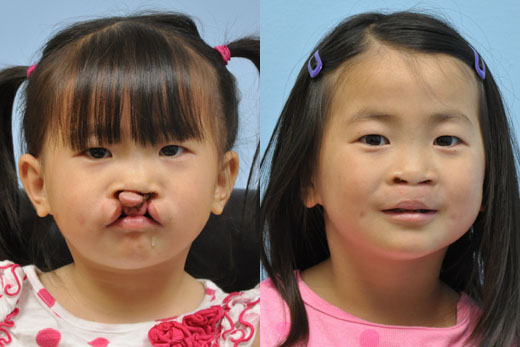Cleft Lip/Nose
Partner with one of the most recognized ENT / Facial Plastics teams in the Midwest to repair cleft lip and cleft palate.
A child born with a cleft lip and palate can be an overwhelming experience for parents, siblings, and relatives. Cleft lip and palate congenital abnormalities are one of most common birth defects affecting approximately 1 in 750 births in the U.S. Although the diagnosis is frequently made by ultrasound during pregnancy, at times it is not discovered until birth. It is important to partner with a team of skilled and caring physicians who will help navigate you and your child through the process of correcting this condition and improving your child’s quality of life.
Expert Care
Dr. Christopher Tolan is a Midwest leader in treating cleft lip and palate congenital deformities. He is also an active Cleft Lip and Palate panel member and meets monthly at St. Paul Children’s Hospital and Clinics.
In addition, he has traveled with the medical missions Love Without Boundaries (LWB), Children’s Surgery International (CSI), and Operation Hope, all-volunteer organizations dedicated to providing surgical management for children and adults who have cleft lip and palate congenital malformations.
What Is a Cleft Lip and Cleft Nose?
Cleft lip and cleft nose are congenital conditions in which a baby is born with a gap in the upper lip and/or nose. This condition affects the appearance and function of the mouth and nasal passages. It can also impact feeding, speech, and overall facial symmetry, making cleft lip surgery and cleft nose correction essential for many children.
Symptoms and Diagnosis
Symptoms of cleft lip and nose vary but commonly include a visible split in the lip or nose, nasal congestion, and challenges with feeding and speech. Diagnosis is made at birth or through prenatal imaging. Early consultation with our facial plastic surgeons can help plan for treatment.
Our Cleft Lip and Nose Surgery Approach at Midwest Facial Plastic Surgery
Midwest Facial Plastic Surgery provides cleft lip treatment using advanced surgical techniques to reconstruct and restore function. Our team prioritizes each child’s unique needs, focusing on enhancing both appearance and functionality through facial plastic surgery.
Treatment of Cleft Lip and Palate
The treatment of Cleft Lip and Palate involves an outline for a staged approach to management. This initially consists of presurgical orthopedics or Nasoalveolar Molding. Usually, this is started within the first weeks of life and helps improve the alignment of the lip, nose, and palate. It is generally continued for 12-16 weeks.
The first stage of surgical repair consists of placing ear tubes and repairing the lip. Repair of the palate is usually delayed until 9-12 months of age. It is not unusual for some children to undergo intermediate procedures in an effort to restore a more normal appearance.
Utilizing a multidisciplinary cleft team approach, including the cleft palate and lip surgeons, speech-language pathologists, audiologists, dentists, orthodontists, oral surgeons, and restorative dentists, helps manage some of the complex issues that may arise. Dr. Tolan will work directly with your medical team to provide the best outcomes for your child and your family.
Indications
Here are indications of when cleft lip or nose surgery is necessary:
- Cleft Lip and Palate: Cleft lip and palate are congenital disabilities where the upper lip and roof of the mouth have openings. Surgery is needed to correct these gaps and improve appearance, speech, and eating ability.
- Congenital Malformations: Congenital malformations are structural abnormalities present at birth affecting various body parts. Treatment typically involves surgery or other therapies to address the issues and enhance quality of life.
Benefits
The benefits of cleft lip surgery include:
- Improved Appearance of Cleft Lip and Palate: Surgery restores a natural, symmetrical look to the lip and palate, enhancing facial aesthetics and overall harmony.
- Improved Function of the Mouth: Surgery improves speech, chewing, and overall oral function, making daily activities easier and promoting oral health.
- Improved Function of the Nose: Reconstructive surgery improves nasal shape and function, enhancing breathing and reducing nasal congestion.
- Improved Confidence: Correcting a cleft lip and palate boosts self-esteem, leading to greater confidence and a better quality of life.
Frequently Asked Questions (FAQs)
When is the best time to have cleft lip and cleft nose surgery?
Cleft lip surgery is performed around three to six months of age, while cleft nose correction may occur later, depending on the child’s development.
What should I expect during the surgery?
The procedure involves precise incisions and tissue rearrangement to close the gap and improve nasal structure. Our surgeons provide detailed guidance on what to expect before and after surgery.
What is the recovery process like?
Recovery varies, but most children return home the same day. Swelling and tenderness are common but subside within a few weeks. Follow-up visits are essential to monitor healing.
Are there any risks associated with cleft lip and cleft nose surgery?
As with any surgery, risks include bleeding, infection, and scarring. Our team prioritizes safety and provides comprehensive care to minimize these risks.
How will surgery affect my child's speech and development?
Cleft lip and nose surgery greatly benefits speech and development by improving mouth and nasal function, enhancing your child’s ability to speak clearly and breathe comfortably.
Learn More with a Consultation
Are you interested in learning more about Cleft Palate and Cleft Lip Surgery in Vadnais Heights, Eagan, and Woodbury? Contact us and schedule a consultation with our facial plastic surgeons. Our Midwest Facial Plastic Surgery team can perform the procedure with the highest patient care for your child’s safety.
Related Procedures
Before + After Results
View before and after photos of surgeries performed by facial plastic surgeons Dr. Christopher Tolan, Dr. Garrett Griffin, Dr. Zachary Farhood, Dr. Sebastian Sciegienka, and Dr. Anna Bakeman in Minneapolis, MN.

